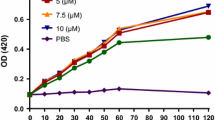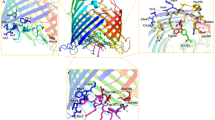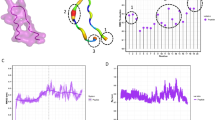Abstract
Despite the huge efforts of microbiologists, infectious diseases have yet remained one of the leading causes of death in humans, further highlighting the research priority for controlling opportunistic pathogens. Many researchers have used antibacterial peptides to solve the problem of antibiotic resistance. This research is thus conducted to investigate the antibacterial and anti-biofilm activity of a novel modified cecropin–melittin 11-peptide with improved therapeutic properties and lower side effects. After synthesis and purification of mCM11 (NH2-WRLFRRILRVL-NH2) by solid-phase synthesis and HPLC methods, respectively, the antibacterial and biofilm inhibitory activities were explored in vitro. TMHMM was used to confirm the reaction of mCM11 on the plasma membrane of the prokaryotic cells. The interaction between mCM11 on Acinetobacter baumannii strains was investigated by molecular docking using ClusPro2.0. Hemolysis and therapeutic indexes were also calculated to quantify the relative safety and adverse effects of mCM11. According to the results, mCM11 has a high inhibitory and lethal effect on A. baumannii strains due to its cationic properties and new specific sequence. Molecular docking revealed the release of a significant amount of energy when mCM11 binds to the surface of A. baumannii in an appropriate site. The findings indicated that mCM11 IC50 (4 μg/mL) lysed 2.78% of RBCs; moreover, 8 strains of Acinetobacter baumannii showed a favorable therapeutic index. The mCM11 exhibits strong antibacterial and antibiofilm activities against A. baumannii strains, suggesting its potential therapeutic role in infections caused by these strains. Similar to its impact on A. baumannii, mCM11 could be a suitable alternative to antibiotics in combat against antibiotic-resistant bacteria in the in vivo experiments.





Similar content being viewed by others
Data Availability
The results obtained and analyzed during this research have been published only in this paper, and the data are also reproducible and are available upon request from the authors.
Abbreviations
- A. b:
-
Acinetobacter baumannii
- A. baumannii :
-
Acinetobacter baumannii
- AMP:
-
Anti-Microbial Peptide
- ATCC:
-
American Type Culture Collection
- BPP:
-
Biofilm Production Power
- CM11:
-
Cecropin–Melittin 11 peptide
- DMRT:
-
Duncan's Multiple Range Test
- E. coli :
-
Escherichia coli
- LBF:
-
Lack of Biofilm Formation
- MBC:
-
Minimum Bactericidal Concentration
- MBF:
-
Moderately Biofilm Formation
- mCM11:
-
Modified CM11
- MDR:
-
Multi-Drug Resistant
- MIC:
-
Minimum Inhibitory Concentrations
- O.D:
-
Optical Density
- ODB:
-
Optical Density of control sample with Bacteria
- ODC:
-
Optical Density of Control sample without bacteria
- ODT:
-
Optical Density of peptide-Treated sample
- PBS:
-
Phosphate-Buffered saline
- PDR:
-
Pan Drug-Resistant
- RBC:
-
Red Blood Cell
- SBF:
-
Strongly Biofilm Formation
- TI:
-
Therapeutic index
- TMHMM:
-
Tied Mixture Hidden Markov Model
- TSB:
-
Tryptic Soy Broth
- WBF:
-
Weakly Biofilm Formation
- WHO:
-
World Health Organization
- XDR:
-
Extensively Drug-Resistant
References
Kaufmann BB, Hung DT (2010) The fast track to multidrug resistance. Mol Cell 37(3):297–298
Peters L et al (2019) Multiple antibiotic resistance as a risk factor for mortality and prolonged hospital stay: a cohort study among neonatal intensive care patients with hospital-acquired infections caused by gram-negative bacteria in Vietnam. PLoS ONE 14(5):e0215666
Cassini A et al (2019) Attributable deaths and disability-adjusted life-years caused by infections with antibiotic-resistant bacteria in the EU and the European Economic Area in 2015: a population-level modelling analysis. Lancet Infect Dis 19(1):56–66
Peterson E, Kaur P (2018) Antibiotic resistance mechanisms in bacteria: relationships between resistance determinants of antibiotic producers, environmental bacteria, and clinical pathogens. Front Microbiol 9:2928–2928
Palmer AC, Kishony R (2013) Understanding, predicting and manipulating the genotypic evolution of antibiotic resistance. Nat Rev Genet 14(4):243–248
Munita JM et al (2016) HHS public access mechanisms of antibiotic resistance. HHS Public Access 4(2):1–37
Mahlapuu M et al (2016) Antimicrobial peptides: an emerging category of therapeutic agents. Front Cell Infect Microbiol 6:194
Brown KL, Hancock RE (2006) Cationic host defense (antimicrobial) peptides. Curr Opin Immunol 18(1):24–30
Bahar AA, Ren D (2013) Antimicrobial peptides. Pharmaceuticals 6(12):1543–1575
Pourhajibagher M et al (2016) Antimicrobial resistance of Acinetobacter baumannii to imipenem in Iran: a systematic review and meta-analysis. Open Microbiol J 10:32
Gopal R et al (2014) Synergistic effects and antibiofilm properties of chimeric peptides against multidrug-resistant Acinetobacter baumannii strains. Antimicrob Agents Chemother 58(3):1622–1629
Hancock RE, Diamond G (2000) The role of cationic antimicrobial peptides in innate host defences. Trends Microbiol 8(9):402–410
Reddy K, Yedery R, Aranha C (2004) Antimicrobial peptides: Premises and promises. Inte JAntimicrob Agents 24(6):536–547
Marr AK, Gooderham WJ, Hancock RE (2006) Antibacterial peptides for therapeutic use: obstacles and realistic outlook. Curr Opin Pharmacol 6(5):468–472
Pasupuleti M, Schmidtchen A, Malmsten M (2012) Antimicrobial peptides: key components of the innate immune system. Crit Rev Biotechnol 32(2):143–171
Hancock RE, Nijnik A, Philpott DJ (2012) Modulating immunity as a therapy for bacterial infections. Nat Rev Microbiol 10(4):243–254
Wu J et al (2004) PR39 inhibits apoptosis in hypoxic endothelial cells: role of inhibitor apoptosis protein-2. Circulation 109(13):1660–1667
Beisswenger C, Bals R (2005) Functions of antimicrobial peptides in host defense and immunity. Curr Protein Pept Sci 6(3):255–264
Craik DJ et al (2013) The future of peptide-based drugs. Chem Biol Drug Des 81(1):136–147
Eshtiaghi S, Nazari R, Fasihi-Ramandi M (2021) In-Silico and In-Vitro Evaluation of Antibacterial, Cytotoxic, and Apoptotic Activity and Structure of Modified CM11 Peptide. Int J Pept Res Ther 27:1069–1078
Ruiz, V., 2020 Structural and Functional Characterization of New Clinically Relevant Enzymes Involved in Antibiotic Resistance
Valencia R et al (2009) Nosocomial outbreak of infection with pan-drug-resistant Acinetobacter baumannii in a tertiary care university hospital. Infect Control Hosp Epidemiol 30(3):257–263
Bagheri Josheghani S et al (2017) Emergence of blaOXA-carrying Carbapenem resistance in multidrug-resistant Acinetobacter baumannii in the intensive care unit. Iran Red Crescent Med J 19(5):e27327
Kapoor K et al (2014) Risk Factors and predictors of mortality in critically ill children with extensively-drug resistant Acinetobacter baumannii infection in a pediatric intensive care unit. Iran J Pediatr 24(5):569–574
Wong D et al (2017) Clinical and pathophysiological overview of Acinetobacter infections: a century of challenges. Clin Microbiol Rev 30(1):409–447
Kanafani ZA et al (2018) Multidrug resistant Acinetobacter species: a seven-year experience from a tertiary care center in Lebanon. Antimicrob Resist Infect Control 7(1):9
Krogh A et al (2001) Predicting transmembrane protein topology with a hidden Markov model: application to complete genomes. J Mol Biol 305(3):567–580
Maupetit J, Derreumaux P, Tuffery P (2009) PEP-FOLD: an online resource for de novo peptide structure prediction. Nucl Acids Res 37(suppl_2):W498–W503
Kozakov D et al (2017) The ClusPro web server for protein–protein docking. Nat Protoc 12(2):255–278
Sarikhani Z, Nazari R, Nateghi Rostami M (2017) First report of OXA-143-lactamase producing Acinetobacter baumannii in Qom Iran. Iran J Basic Med Sci 20(11):1282–1286
Clinical and Laboratory Standards Institute guidelines (CLSI). 2019; Available from: https://clsi.org/
Namasivayam R, Robin G, Latha BK (2012) Biofilm inhibitory effect of silver nanoparticles coated catheter against staphylococcus aureus and evaluation of its synergistic effect with antibioTICS. Int J Biol Pharm Res 3(2):259–265
Habibipour R, Moradi Haghgou L (2015) Study on hydro-alcoholic extract effect of pomegranate peel on Pseudomonas aeruginosa biofilm formation. Avicenna J Clin Med 22(3):195–202
Ishnava KB, Shah PP (2014) Anticariogenic and hemolytic activity of selected seed protein extracts in vitro conditions. J Dent (Tehran) 11(5):576–586
Willyard C (2017) The drug-resistant bacteria that pose the greatest health threats. Nature 543(7643):15
Benfield AH, Henriques ST (2020) Mode-of-action of antimicrobial peptides: membrane disruption versus intracellular mechanisms. Front Med Technol 2:20
Kumar P, Kizhakkedathu JN, Straus SK (2018) Antimicrobial peptides: diversity, mechanism of action and strategies to improve the activity and biocompatibility in vivo. Biomolecules 8(1):4
Ghadimi S , F.-R.M., Rational design of novel analogs CM11 antimicrobial peptide based sequence variations with Bioinformatics data. National Congress Of Research and Innovation in Biotechnology. 07.
Rodríguez-Hernández MJ et al (2006) Studies on the antimicrobial activity of cecropin A–melittin hybrid peptides in colistin-resistant clinical isolates of Acinetobacter baumannii. J Antimicrob Chemother 58(1):95–100
Giacometti A et al (2003) Comparative activities of cecropin A, melittin, and cecropin A-melittin peptide CA(1–7)M(2–9)NH2 against multidrug-resistant nosocomial isolates of Acinetobacter baumannii. Peptides 24(9):1315–1318
Czyzewski AM et al (2016) In vivo, in vitro, and in silico characterization of peptoids as antimicrobial agents. PLoS ONE 11(2):e0135961
Onime LA et al (2021) The rumen eukaryotome is a source of novel antimicrobial peptides with therapeutic potential. BMC Microbiol 21(1):1–13
Azizi Bar**i K, M.M.M., Amani J , Asadi A, and Borna H, In-silico Analysis of Interaction CM11 and CM15 Hybrid Antimicrobial Peptides with Bacterial Cell Membrane. The 2nd International congress of microbiology, Ardabil university of medical science.
Moghaddam MM et al (2014) Investigation of the antibacterial activity of a short cationic peptide against multidrug-resistant Klebsiella pneumoniae and Salmonella typhimurium strains and its cytotoxicity on eukaryotic cells. World J Microbiol Biotechnol 30(5):1533–1540
Ferre R et al (2006) Inhibition of Plant-pathogenic bacteria by short synthetic Cecropin A-Melittin hybrid peptides. Appl Environ Microbiol 72(5):3302–3308
Kim J et al (2019) development of a novel short 12-meric papiliocin-derived peptide that is effective against Gram-negative sepsis. Sci Rep 9(1):3817
Mousavi Z, A.M., Tahmourespour M,and Mohammadi F., Antibacterial effect of lactoperoxidase protein and its peptides on some bacteria causing mastitis in dairy cattle by molecular docking method. . Veterinary Researches & Biological Products No 127 p 100–109[ In Persian].
Yami HA, Tahmoorespur M, Azghandi M (2019) Antibacterial effect of protein and bioactive peptides of Alpha S1-Casein, on bacterial mastitis in different species of mammals with docking method. J Rumin Res 6(4):51–64
Khademi M, Nazarian-Firouzabadi F, Ismaili A (2019) Cloning and expression of two new recombinant antimicrobial dermaseptin B1 peptides in tobacco to control the growth of human bacterial pathogens. J Mazandaran Univ Med Sci 29(176):47–60
Acknowledgements
This research was carried out using the facilities of IAU, Qom Branch. The authors thank Mohammad Eshtiaghi, Mansoureh Algharnia, Samaneh Banaeian Kalaat, Fahimeh Afzali, Zahraa Karimi, Alborz translation bureau, and Project Sara Ojdanesh Institute.
Funding
This research did not receive any specific grant from funding agencies in the public, commercial, or nonprofit sectors.
Author information
Authors and Affiliations
Contributions
SE, RN, and MF-R were involved in the design of this study, Laboratory works, Data collection, Statistical analysis, and writing the Draft manuscript. All the authors also cooperated in editing and improving the final version of the article. Design the research: S, R and M. Data collection: S, R and M. Laboratory work: S, R and M. Statistical analysis: S, R and M. Manuscript draft: S, R and M. All authors helped edit and approve the final version of this manuscript for submission. They also contributed to finalizing the manuscript and approved the final draft.
Corresponding author
Ethics declarations
Competing interests
The authors of this study confirm that there is no conflict of interest.
Ethical Approval
The preparation of the A. baumannii strains and samples of this research was approved by the ethics committee of IAU- Qom branch (IR.IAU.QOM.REC.1398.004).
Consent to Participate
In this research entitled "TI Analysis of an mCM11 Peptide; Hemolytic, Antibacterial, and Anti-biofilm Activity on A. baumannii strains", no human or direct sample of human tissue were used.
Consent to Publish
Not applicable.
Additional information
Publisher's Note
Springer Nature remains neutral with regard to jurisdictional claims in published maps and institutional affiliations.
Supplementary Information
Below is the link to the electronic supplementary material.
Rights and permissions
Springer Nature or its licensor (e.g. a society or other partner) holds exclusive rights to this article under a publishing agreement with the author(s) or other rightsholder(s); author self-archiving of the accepted manuscript version of this article is solely governed by the terms of such publishing agreement and applicable law.
About this article
Cite this article
Eshtiaghi, S., Nazari, R. & Fasihi-Ramandi, M. Molecular Docking, Anti-Biofilm & Antibacterial Activities and Therapeutic Index of mCM11 Peptide on Acinetobacter baumannii Strains. Curr Microbiol 80, 191 (2023). https://doi.org/10.1007/s00284-023-03217-z
Received:
Accepted:
Published:
DOI: https://doi.org/10.1007/s00284-023-03217-z




